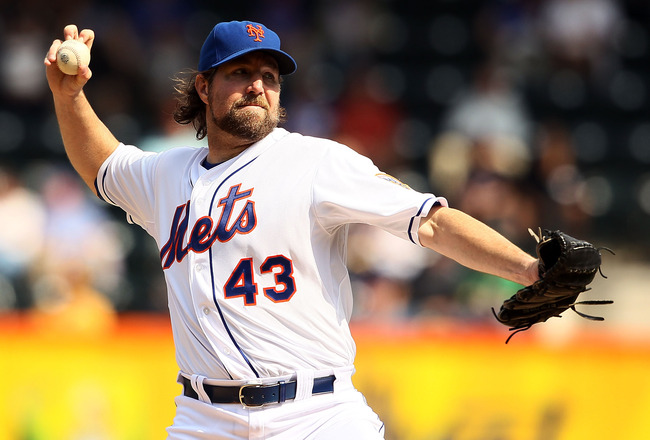
This offseason, we’re looking at the Mets’ history with free agency: their best uses of money and their worst. Number 10 was an unlikely pitcher who turned into one of the best performers during the late 1990s and early 2000s while also becoming one of the most underrated players in team history. We continue with another pitcher who pathed a unique road to stardom.
The knuckleball is the most fascinating, and now rarest, pitch in baseball. It’s impossible to know where it will land once it leaves a pitcher’s hand. R.A. Dickey‘s career, much like that pitch he primarily used, was in considerable flux after the 2009 season.
But over a span of three years, Dickey went from minor league signee to Cy Young Award winner. In between, he led the Mets in ERA over his tenure in New York and totaled a 12.9 WAR with a 1.150 WHIP. The peak of his Cinderella story came in 2012, a year that saw him become the best pitcher in the league. Dickey topped the NL in games started, complete games, shutouts, innings pitched, strikeouts, and batters faced, tossed consecutive one-hitters, made his first All-Star Game, and became a 20-game winner.
With his value high and the Mets’ hopes for contention still far away, Dickey was traded to Toronto. It was a deal that brought prospects Noah Syndergaard and Travis d’Arnaud to the Mets system, making the payoff for this modest acquisition even more lucrative.
Dickey defied the odds by simply making it into professional baseball. Even without an ulnar collator ligament, he became a first-round draft pick of the Texas Rangers. He spent parts of his first seven seasons with three clubs, during which he converted himself into a knuckleballer. Yet he wasn’t finding even modest success. So when the Mets inked the 35-year-old to a contract on December 21, 2009, the team optioned him to Triple-A Buffalo where he’d provide depth and perhaps even be a de facto coach to the younger pitchers.
When there was a hole to fill in the big-league rotation early in 2010, Dickey got the call. His age was never a concern as much as past performance. Thirty-five for an ordinary pitcher is on the older side, but like the Niekros and Charlie Hough before him, it has little effect on one who tosses a flutterball that relies on precision more than power.
Dickey pitched well right away and finished the year with 2.84 ERA. He was solid again the next year, leading the club in innings pitched. But as good as those two seasons were, they couldn’t have prepared anyone for what Dickey would do in 2012.
He won seven of his first eight decisions through May with an ERA close to 3.00. Then came June, which was especially historic. Dickey established the Mets’ franchise record for scoreless innings at 32.2 (which would eventually grow to 44.2). It was on that same night he held Tampa to one hit (and some argue it shouldn’t have even been that many).
Five days later, he somehow topped himself. Not only did he throw another one-hitter (this against Baltimore), he set a career-high in strikeouts with 13. Dickey became the only pitcher to throw consecutive one-hitters with at least 10 Ks and he became the only pitcher in major league history to have five consecutive starts without giving up any earned runs and still getting at least eight strikeouts in each.
Dickey matched that career-high strikeout total on September 27 on the same occasion in which he got win No. 20. While that number remains a milestone for pitchers in spite of its depreciating value, it was his 2.73 ERA, as well as his league-leading 2330 strikeouts five complete games, and three shutouts that sinched the Cy Young.
R.A. Dickey never reached the same heights after that tremendous 2012 season, but his career was still a triumph as evidenced by his recent inclusion on the 2023 Hall of Fame ballot. Dickey’s success as a Met is one of the more pleasant surprises. And his unexpected rise to be the NL Cy Young winner, considering what he overcame beyond the playing field, is one of the heartwarming stories of any baseball player.















